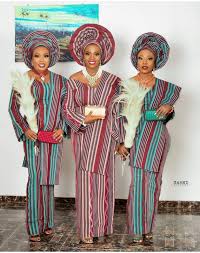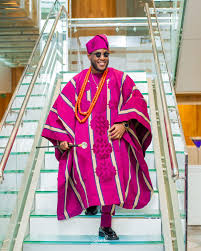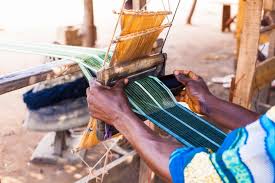Aso-oke is a traditional handwoven fabric worn by the Yoruba people of Nigeria, often for special
occasions like weddings, festivals, and ceremonies.
It is usually made from cotton or silk and comes in various patterns and colors, each with its symbolic meaning.
Aso-oke can be worn as clothing, headwraps, or used as decorative accessories.
In the vibrant tapestry of Nigerian culture, few elements stand out as prominently as Aso Oke.
This traditional handwoven fabric, cherished by the Yoruba people, holds within its threads a rich history,
deep symbolism, and an enduring legacy of craftsmanship.
From weddings to festivals, Aso Oke weaves its way into every significant moment, adorning the wearer with elegance and cultural pride.
Aso Oke, a traditional handwoven fabric hailing from the Yoruba culture in Nigeria, is a masterpiece of artistry
and cultural significance.
To see a video on how to make Aso-oke click here: https://www.youtube.com/watch?v=I_hJwWEgarI
This luxurious textile has been an integral part of ceremonies, celebrations, and everyday life
for generations, weaving together history, craftsmanship, and elegance.
Origins and Craftsmanship
The roots of Aso-oke date back centuries, tracing its origins to the Yoruba people of Nigeria. The term “Aso-oke” translates to “top cloth” in the Yoruba language, signifying its esteemed status in their culture.
Handcrafted with meticulous care and precision, Aso-oke embodies the artistry and skill passed down through generations of weavers.
The weaving process involves intricate techniques, including the use of narrow-strip looms and complex patterns.
Skilled artisans painstakingly create geometric designs, motifs, and color combinations that reflect cultural symbols, social status, and individual preferences.
Symbolism and Significance
Beyond its aesthetic appeal, Aso-oke carries profound symbolism embedded within its fabric.
Each pattern, color, and motif holds meaning, conveying messages of heritage, spirituality, and social identity.
Colors
Aso-oke comes in a myriad of colors, each with its significance. White symbolizes purity and spirituality, often worn for religious ceremonies.
Red represents vitality, love, and celebration, making it a popular choice for weddings and festivals. Indigo, derived from natural dyes, symbolizes wisdom, knowledge, and cultural heritage.
Motifs
Traditional Yoruba motifs such as “Aso Iborun” (shoulder cloth), “Ipele” (shawl), and “Sanyan” (striped cloth) are commonly found in Aso-oke designs.
These motifs carry cultural meanings and historical narratives, connecting the wearer to their roots and ancestral traditions.

Social Status
Historically, Aso-oke was reserved for royalty and aristocrats, serving as a symbol of prestige and social standing. Today, it continues to hold significance in Nigerian society, with variations in design and quality reflecting the wearer’s status and occasion.
The Art of Weaving
Aso-oke is meticulously handwoven by skilled artisans, often using narrow strips of cotton or silk threads.
The process involves careful attention to detail, as the weavers create intricate patterns and designs,
showcasing their expertise and creativity. The resulting fabric is not just clothing; it’s a tangible expression of cultural heritage.
Celebrating Tradition in Modern Times
Despite the winds of change, Aso-oke remains deeply ingrained in Nigerian culture, evolving with the times while preserving its essence.
In contemporary Nigerian weddings, Aso-oke plays a central role, adorning brides and grooms in resplendent attire that pays homage to tradition and heritage.
Moreover, Aso-oke has transcended its cultural boundaries, gaining recognition on the global stage.
From fashion runways to red-carpet events, it’s timeless elegance and cultural significance captivate audiences worldwide, fostering appreciation for Nigerian craftsmanship and heritage.
Versatility in Fashion
Beyond its ceremonial use, Aso-oke has found its way into contemporary fashion.
Designers worldwide have embraced this traditional fabric, incorporating it into modern clothing, accessories, and even home decor.
The fusion of traditional craftsmanship with contemporary styles has given Aso-oke a global appeal, making it a sought-after material for fashion enthusiasts.

Preserving a Cultural Legacy
As we celebrate the beauty and significance of Aso-oke, it is essential to recognize the importance of preserving its cultural legacy.
Supporting local artisans, promoting sustainable practices, and safeguarding traditional weaving techniques are crucial steps in ensuring that Aso-oke continues to thrive for generations to come.
Despite modern influences, the art of Aso-oke weaving continues to thrive, thanks to dedicated artisans and cultural enthusiasts.
Efforts to preserve and promote this traditional craft not only contribute to the livelihoods of skilled weavers but also ensure that future generations can continue to experience the richness of Yoruba culture.
In a world where cultural heritage faces myriad challenges, Aso-oke stands as a testament to the resilience of tradition and the enduring power of craftsmanship.
With each intricately woven thread, it tells a story of resilience, creativity, and the timeless beauty of Nigerian culture.
Moreover, Aso-oke is more than a fabric; it’s a living testament to the rich cultural heritage of the Yoruba people.
Its vibrant colors, intricate patterns, and deep symbolism make it a treasure worth cherishing. As we celebrate the artistry and tradition behind Aso Oke, let us recognize the importance of preserving such cultural gems
that weave our past, present, and future together in threads of elegance and pride.
Read More: https://placesandlifestyle.com/unleashing-your-style-a-journey-into-the-world-of-fashion/




